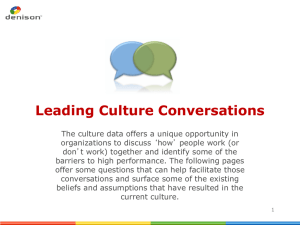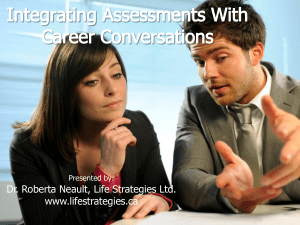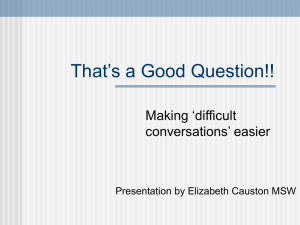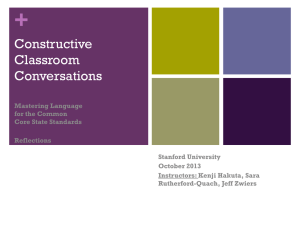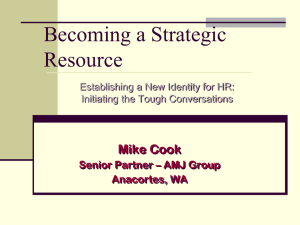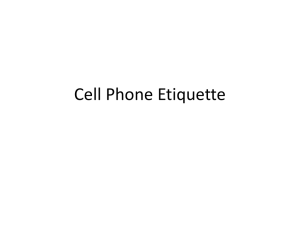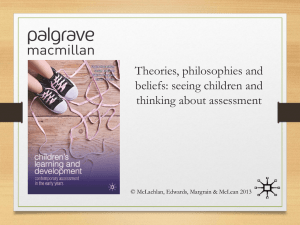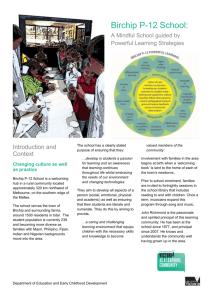7-Assessment-for-Development-and
advertisement
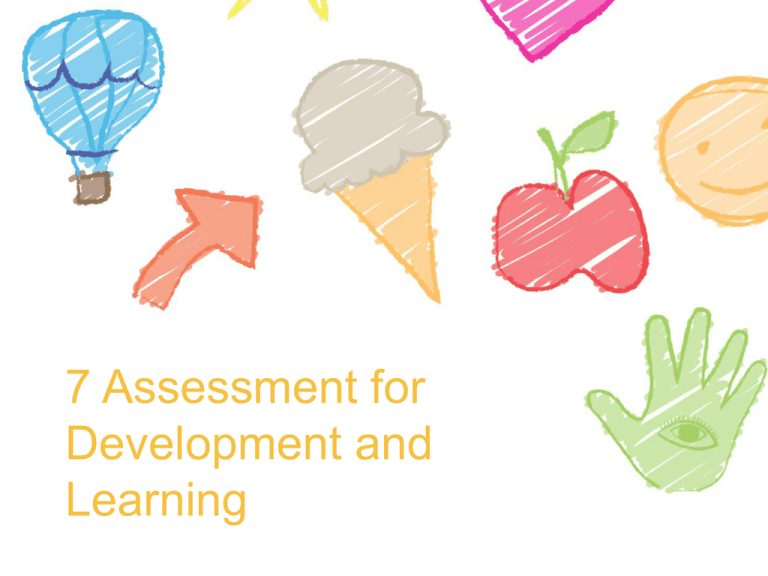
7 Assessment for Development and Learning Assessment for learning and development …the process of gathering and analysing information about what children know, can do and understand. It is part of an ongoing cycle that includes planning, documenting and evaluating children’s learning Source: Early Years Learning Framework for Australia (EYLF), DEEWR 2009, p. 17. early childhood professionals … • Assess the progress of children’s learning and development, what children are ready to learn and how they can be supported • Use a range of assessment tools, processes and approaches to build on prior learning, avoid duplication and add value • Understand that families play a vital role in their children’s learning and development early childhood professionals … (cont.) • Are aware of the health and wellbeing of the family when planning for the child’s learning and development • Assess children’s learning in ways that: – inform their practice – include children’s views of their own learning – are authentic and responsive to how children demonstrate their learning and development early childhood professionals … (cont.) – draw on families’ perspectives, knowledge, experiences and expectations – consider children in the context of their families and provide support to families when necessary – value the culturally specific knowledge embedded within communities about children’s learning and development early childhood professionals … (cont.) – are transparent and objective, and provide families with information about their children’s learning and development, and about what they can do to further support their children – gather and analyse information from a wide range of sources to help them assess and plan effectively – provide the best possible advice and guidance to children and their families Examples of strategies and tools • Maternal and child health nurses use key ages and stages framework and parents’ evaluation of developmental status (PEDS) • Educators in education and care settings use anecdotal records • Teachers in the early years of school use english online interview • Early childhood intervention professionals use play-based assessment Three common kinds of assessment • Assessment of learning and development • Assessment as learning and development • Assessment for learning and development All types of assessment strategies contribute to assessment for learning and development Assessment of learning and development • Summarises what children know, understand and can do at a particular point in time • Includes large-scale, population assessment strategies such as the National Assessment Program - Literacy and Numeracy (NAPLAN) and the Australian Early Development Index • A transition learning and development statement is also an example of a summary statement which can be helpful when there are shared concerns about a child’s learning and development Assessment as learning and development • Occurs when professionals involve children actively in assessing their learning and development • By monitoring and thinking about what and how they learnt with adults and peers, children see themselves as learners and can use this information to learn more effectively and take more control over their learning • Assessment as learning recognises that children are competent and capable learners from birth • When professionals ask children to explain how they learnt something or who helped them to learn, they are using assessment as a tool to support learning Assessment for learning and development • Is a continuous process of finding out what children know, understand, and can do in order to plan what next, building on previous learning and supporting new learning Assessing for learning and development Professionals analyse and interpret the information they collect through critical reflection and discussion with colleagues, families, children and other professionals using: – knowledge of child development and learning – deep understanding of the Learning and Development Outcomes including dispositions for learning – knowledge of the child’s social and cultural background (the child in context) – families’ understanding about their children’s learning and development at home and in the local community – information from other professionals involved with the child Why assess? • Assessment allows professionals to: – use/interpret evidence to identify what children already know, can do and are ready to learn – monitor children’s progress and achievements over time – make decisions about experiences and opportunities to advance learning and development in response to individual children’s strengths, abilities, interests and needs – identify children who may benefit from additional or specialised support and what these supports should be Why assess? (cont.) • Assessment allows professionals to: – communicate and collaborate with children, families and other professionals about children’s learning and development – work in partnership with families and children to plan meaningful learning experiences – recognise that what professionals plan, do, say and provide contributes to every child’s learning – evaluate and improve curriculum decision-making so that what is planned has rigour – that is it is meaningful and worth children knowing and doing Empowering children through assessment • Children’s awareness of progress • Meta-cognition and its link to learning dispositions • Professionals modelling and talking • Assessment as a dynamic process Early Years Planning Cycle Collect information • Assessment requires professionals to collect information about children’s learning and development using a range of strategies and tools including (but not limited to): – observations (for example, running records, anecdotal records) – conversations and interviews with children – samples of children’s work – checklists – rating scales Collect information (cont.) – video or audio recordings of children’s conversations or play – webs of children’s ideas about a topic from initial discussions and throughout a project – photographs – event and time sampling – tests – conversations with families, colleagues and other professionals Question/analyse • What is the child learning currently? • What is the child showing me that they have learnt? • What is the child ready to learn? How do you know that? • What gaps are there in the learning? Is there learning you expected to observe that is not evident? Why might it be missing? Question/analyse (cont.) • Who or what is helping the learning? • What is interfering with the learning? • At what stage is the learning – beginning, emerging, exploratory, practising, consolidating, extending, confident, mastery? • What learning disposition(s) is the child using? • What is the purpose of the learning? Plan Decide what to do next based on your analysis and discussions with others and on the understanding that the child’s experience across the entire session or day matters and needs to be planned for Act and do Implement plans using intentional strategies to ensure children’s learning progresses Review • Reflect on what works well and what doesn’t (in terms of children’s learning and your professional practice) and how children are being supported to learn across all the learning and development outcomes • Consider other services and supports you could link with to provide better support to a child and their family Effective assessment • Uses authentic and appropriate approaches • Provides an holistic understanding of each child’s learning and development • Is objective and non-judgemental • Is ongoing, measuring progress over time Effective assessment (cont.) • Recognises cultural diversity and perspectives • Incorporates children’s views • Incorporates families’ and other professionals’ views • Incorporates and uses assessment of all aspects of the curriculum or program Authentic assessments take place … • In environments that are familiar and natural to children • When children are comfortable • When children can engage with experiences, materials and equipment that interest them • In everyday experiences Authentic assessments take place when children… • Have conversations with other children and with adults • Participate in daily routine experiences such as mealtimes • Engage in child-directed play indoors and outdoors • Take part in adult-led experiences, such as learning a new song • Are on their own • Interact with others • Face challenges assessments need to be… • Be both informal and more formal (e.g. observations or a standardised assessment tool) • Occur in a number of different ways • Take place in different contexts and settings (e.g. during arrival time and in outdoor play experiences) • Be culturally appropriate • Use a variety of tools or strategies appropriate for the purpose Holistic assessment in practice • Involves exploring and assessing different aspects of children’s learning and development in different contexts, environments and relationships • Helps professionals gain a clear and comprehensive picture of children’s learning and development so they can plan appropriately across all the Learning and Development Outcomes objective assessment in practice • Involves exploring and assessing different aspects of children’s learning and development in different contexts, environments and relationships • Helps professionals gain a clear and comprehensive picture of children’s learning and development so they can plan appropriately across all the Learning and Development Outcomes Children’s learning and ongoing assessment • Behaviour varies from day-to-day and situation to situation • Learning is not linear or a step-by-step process • Earning requires them to actively make sense of what they experience, hear, see and do • Learning is competent from birth ongoing assessment over time • Most informative assessments take place continually over a period of time with a range of assessment tools or strategies • Distance travelled may include major changes or small steps in learning, all of which should be recognised and used to inform planning what next for a child Culturally and linguistically appropriate assessment in practice Assessment needs to take into account how family, cultural and language backgrounds influence the knowledge and skills that children acquire and the type of learning opportunities they have Incorporating children’s views • The VEYLDF promotes the idea that learning is most effective when children are active agents or participants in and contributors to their learning and the assessment of their learning • Children benefit from getting feedback from professionals and other children about their learning and development Creating Shared, sustained interactions and conversations with children • • • • Ask authentic open-ended questions Encourage children to ask questions Make meaningful comments Offer explanations at times and also encourage children to explain • Promote collaborative problem-solving Creating Shared, sustained interactions and conversations with children (cont.) • Clarify concepts or ideas • Collaborate to create new ideas together (coconstruction) • Make connections with previous learning • Extend conversations • Discuss children’s theories and hypotheses families’ views • Play an essential role in their children’s learning and development • Are a valuable source of information about their children • Can give information about their children’s past experiences, cultural background, temperament, interests, abilities, behaviour and learning in different settings Evaluation of curriculum or program components Professionals not only assess children’s learning, they also evaluate or assess their program or curriculum (environments, resources, routines, experiences, events, interactions, conversations) and how it supports or limits children’s learning and development
